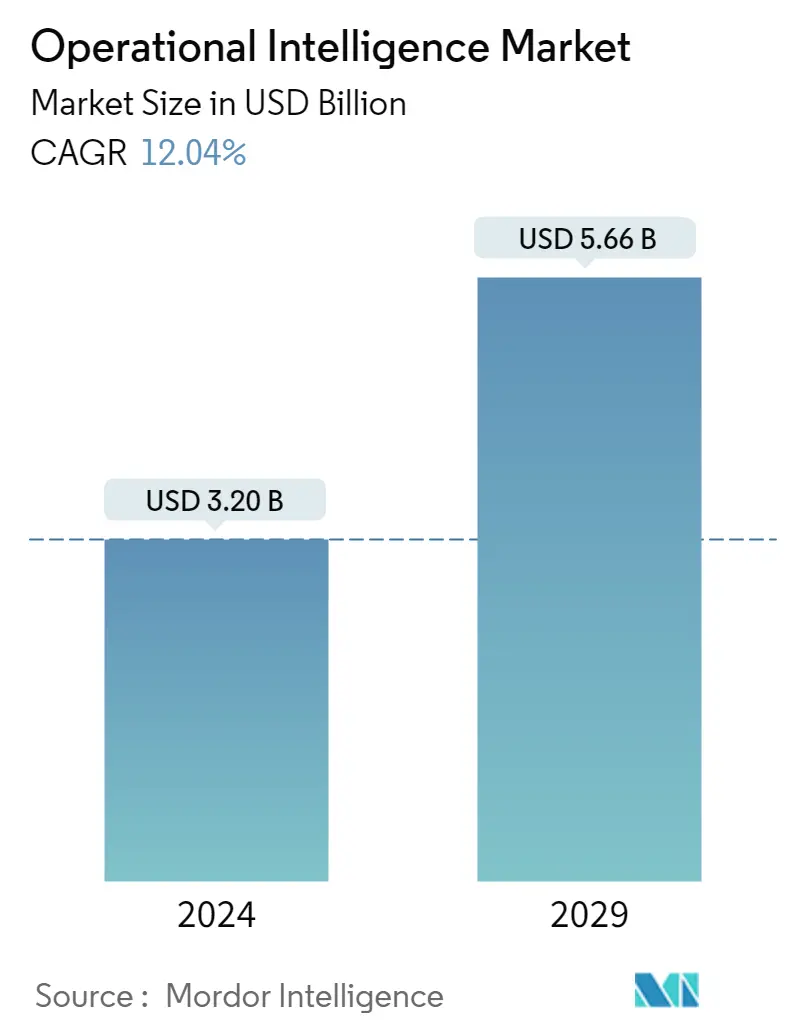Market Size of Operational Intelligence Industry

| Study Period | 2019 - 2029 |
| Market Size (2024) | USD 3.20 Billion |
| Market Size (2029) | USD 5.66 Billion |
| CAGR (2024 - 2029) | 12.04 % |
| Fastest Growing Market | Asia Pacific |
| Largest Market | North America |
| Market Concentration | Low |
Major Players
*Disclaimer: Major Players sorted in no particular order |
Operational Intelligence Market Analysis
The Operational Intelligence Market size is estimated at USD 3.20 billion in 2024, and is expected to reach USD 5.66 billion by 2029, growing at a CAGR of 12.04% during the forecast period (2024-2029).
Operational intelligence (OI) is a form of dynamic, real-time business analytics that delivers insights into business and IT operations. These solutions provide enterprises with the opportunity to streamline the process of data collection and analysis. Enterprises can monitor and troubleshoot in real time and improve their security and compliance methods, thereby speeding up the delivery of their services to customers.
- The need for quality management, data discovery, and visualization is compelling businesses to adopt operational intelligence software. OI solutions can take immediate action on insights using automated processes and workflows by streaming Big Data and intricate IT-infrastructure events and processes.
- Increasing adoption of big data analytics and the Internet of Things (IoT) across end-users drives the market. With the emergence of Big Data and the increasing need to make critical business decisions within a compressed timeframe, operational intelligence (OI) and analytics tools have gained a substantial market share in the past decade.
- The emerging Internet of Things (IoT) extends digital connectivity to devices and sensors in homes, businesses, vehicles, and potentially almost anywhere. This innovation means that virtually any device can generate and transmit data about its operations - data to which analytics can be applied to facilitate monitoring and a range of automatic functions. The growing need for real-time data analytics drives the market. The impact of operational intelligence in a data-driven world is clear and is rising significantly.
- With the rising deployment of operational intelligence, new market issues have emerged. Some primary difficulties fundamentally pushing back the operational intelligence market include a shortage of skilled professionals, complexity in data transfer, handling to handle business requirements, and high cost. As the market grows, the cost of initial investment and execution rises due to increased demand and customization of products to meet specific needs. The implementation of OI is a costly procedure. The process's extensive programming and data integration adds time and expense. Most providers charge a fee for software upgrades. Additionally, OI software is complex, and consultants or qualified specialists often operate it.
- Rapid technological advancements, cloud computing, and big data analytics have recently gained popularity during the pandemic. Cloud computing is an advanced platform for delivering BI applications and serves as a storage for structured and unstructured data. Similarly, big data technology has enabled these tools to analyze massive volumes of data to give organizations actionable insights that aid in evaluating prospects and improving marketing campaigns. The enhancing support and services from deploying the cloud will also remain a significant factor in boosting the studied market post-pandemic.
Operational Intelligence Industry Segmentation
The need for operational intelligence systems is increasing because of the growing workflows and complex planning programs. The OI helps enterprises do business in the mobile world, develop various strategies, and monitor customized workflows. The market study comprises deployment such as on-premise and cloud, which caters to various end-user verticals such as retail, manufacturing, BFS, government, and IT and telecommunication.
The operational intelligence market can be segmented by deployment type (cloud, on-premise), end-user vertical (retail, manufacturing, BFSI, government, IT and telecommunication, military and defense, transportation and logistics, healthcare, and energy and power), geography (North America, Europe, Asia-Pacific, Latin America, Middle East and Africa).
The market sizes and forecasts are provided in terms of value in USD million for all the above segments.
| By Deployment Type | |
| Cloud | |
| On-premise |
| By End-user Vertical | |
| Retail | |
| Manufacturing | |
| BFSI | |
| Government | |
| IT and Telecommunication | |
| Military and Defense | |
| Transportation and Logistics | |
| Healthcare | |
| Energy and Power |
| By Geography | |
| North America | |
| Europe | |
| Asia-Pacific | |
| Latin America | |
| Middle East and Africa |
Operational Intelligence Market Size Summary
The operational intelligence market is poised for significant growth, driven by the increasing need for real-time business analytics and the adoption of big data and IoT technologies. These solutions enable enterprises to streamline data collection and analysis, enhancing their ability to monitor, troubleshoot, and improve security and compliance in real time. The market is characterized by the integration of cloud computing and big data analytics, which provide organizations with actionable insights to optimize operations and marketing strategies. Despite the promising growth, challenges such as a shortage of skilled professionals, high implementation costs, and the complexity of data integration remain hurdles for widespread adoption.
The Asia-Pacific region is expected to experience the highest growth due to government digitization initiatives and rapid technological advancements. Countries like China, India, Japan, and South Korea are witnessing increased investor interest in operational intelligence, fueled by digital transformation efforts and substantial private sector investments. The market is highly fragmented, with major players like Vitria Technology Inc., Splunk Inc., and SAP SE adopting strategies such as partnerships and innovations to enhance their offerings. The shift towards cloud services, particularly hybrid cloud solutions, is gaining traction as organizations seek cost-effective, scalable, and centralized services to support their digital transformation journeys.
Operational Intelligence Market Size - Table of Contents
-
1. MARKET INSIGHTS
-
1.1 Market Overview
-
1.2 Industry Attractiveness - Porter's Five Forces Analysis
-
1.2.1 Threat of New Entrants
-
1.2.2 Bargaining Power of Buyers/Consumers
-
1.2.3 Bargaining Power of Suppliers
-
1.2.4 Threat of Substitute Products
-
1.2.5 Intensity of Competitive Rivalry
-
-
1.3 Impact of COVID-19 on the Market
-
-
2. MARKET SEGMENTATION
-
2.1 By Deployment Type
-
2.1.1 Cloud
-
2.1.2 On-premise
-
-
2.2 By End-user Vertical
-
2.2.1 Retail
-
2.2.2 Manufacturing
-
2.2.3 BFSI
-
2.2.4 Government
-
2.2.5 IT and Telecommunication
-
2.2.6 Military and Defense
-
2.2.7 Transportation and Logistics
-
2.2.8 Healthcare
-
2.2.9 Energy and Power
-
-
2.3 By Geography
-
2.3.1 North America
-
2.3.2 Europe
-
2.3.3 Asia-Pacific
-
2.3.4 Latin America
-
2.3.5 Middle East and Africa
-
-
Operational Intelligence Market Size FAQs
How big is the Operational Intelligence Market?
The Operational Intelligence Market size is expected to reach USD 3.20 billion in 2024 and grow at a CAGR of 12.04% to reach USD 5.66 billion by 2029.
What is the current Operational Intelligence Market size?
In 2024, the Operational Intelligence Market size is expected to reach USD 3.20 billion.

